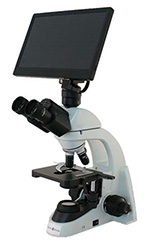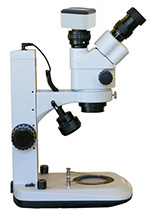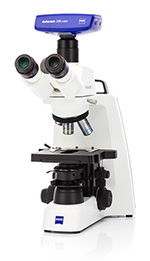Digital Microscope Buying Guide
Choosing a digital microscope depends upon the application you have in mind. Will you be observing small, solid objects such as rocks or coins, or tiny, more transparent objects such as blood cells and pond water?
 Here's why we ask: There are two types of digital microscopes, high power and low power. High power microscopes - also known as compound microscopes - are more popular and are most often selected by schools for use in biology and chemistry labs. High power microscopes are used for looking at microscopic materials like blood cells and living organisms that exist in water drawn from a local stream or pond. High power microscopes transmit light through the specimen in order to make it visible. High power microscopes have magnification of up to 1000x even though most applications only require 400x.
Here's why we ask: There are two types of digital microscopes, high power and low power. High power microscopes - also known as compound microscopes - are more popular and are most often selected by schools for use in biology and chemistry labs. High power microscopes are used for looking at microscopic materials like blood cells and living organisms that exist in water drawn from a local stream or pond. High power microscopes transmit light through the specimen in order to make it visible. High power microscopes have magnification of up to 1000x even though most applications only require 400x.
The microscope show on the right is the UX1-LCD digital microscope and it includes a monitor for viewing live images. This digital microscope is perfect for classrooms where kids might gather around a microscope and want to all see the sample at the same time.
At the left is the ZEISS Primostar 3 digital microscope. This is a popular compound digital microscope used in classrooms. The camera provides 8 megapixels for image capture and can be used with a computer. Basic image capture software is included. The camera also has HDMI output for easy connection into a large monitor or LCD projector. There are options to order this microscope with only 400x magnification, or add the 1000x magnification.
 Low power digital microscopes, or stereo microscopes, often have both an upper and lower light that will either reflect or transmit light which allows for looking at transparent specimens as well as solid. However, 80x is usually the maximum magnification, and 20-40x is the more commonly used magnification range, which makes the low power microscope ideal for coin collectors, stamp collectors, entomologists, geologists, and jewelry makers. Low power microscopes typically have two eyepieces that work in conjunction with an objective lens giving a specimen "depth" or a 3D appearance when viewing. There are three types of low power microscopes and the kind of application for your purposes will determine which type will work best for you: Single power (a single magnification), dual power (two magnification options) and Zoom (a range of magnification options from which to choose). Zoom magnification microscopes are the easiest to use, as you can see a wide range of magnifications and choose the one that works best for your needs.
Low power digital microscopes, or stereo microscopes, often have both an upper and lower light that will either reflect or transmit light which allows for looking at transparent specimens as well as solid. However, 80x is usually the maximum magnification, and 20-40x is the more commonly used magnification range, which makes the low power microscope ideal for coin collectors, stamp collectors, entomologists, geologists, and jewelry makers. Low power microscopes typically have two eyepieces that work in conjunction with an objective lens giving a specimen "depth" or a 3D appearance when viewing. There are three types of low power microscopes and the kind of application for your purposes will determine which type will work best for you: Single power (a single magnification), dual power (two magnification options) and Zoom (a range of magnification options from which to choose). Zoom magnification microscopes are the easiest to use, as you can see a wide range of magnifications and choose the one that works best for your needs.
The S6-Wifi Stereo Microscope is shown at right and is popular in classrooms where students can download an App onto their tablet or phone and view images from the microscope.
The "digital" aspect of both high power and low power microscopes is the built-in digital camera. The microscope functions as a standard microscope, but when connected to the computer, the included software allows the teacher to show the microscope image on a screen, capture and save images and video, as well as make measurements. The images of the specimen can be projected on a computer monitor or large screen. Images created by the digital microscope can also be captured and used with other programs for other presentation opportunities such as PowerPoint®. When using a digital microscope, it is recommended that you have the ability to capture images at high resolutions (1,280 × 1,024 or higher) which will allow you to print or project the image with a great degree of detail. A resolution of 640 × 480, will render a decent image satisfactorily viewable on a computer monitor but this is a size that cannot be increased without sacrificing clarity. Many digital microscopes offered by Microscope World include software for viewing and capturing live images on the computer.
Microscope World does not recommend purchasing a microscope that has a camera "built-in". The life of the microscope almost always outlives the camera, and if your camera is built into the microscope it can not be replaced with newer technology or hardware.
If you have questions about which digital camera is best for your microscopy needs, please contact us for more information.

